 NÖRDLINGER,
Benno,
NÖRDLINGER,
Benno,
The Jewish
Community
of
La
Book Pages 384 - 390
 Inn "Zum Ochsen", 23 Kapellenstrasse , 4 Radstrasse
Inn "Zum Ochsen", 23 Kapellenstrasse , 4 Radstrasse
KARL NEIDLINGER
Benno Nördlinger, born November 14, 1895 in Laupheim, died 1979 in New York,
Sophie Nördlinger, née Sänger, born April 3, 1898 in Laupheim, died 1993 in Chicago. Sophie Nördlinger’s mother:
Klara Sänger, née Einstein, born April 8, 1865 in Laupheim, died October 15, 1942 in New York.
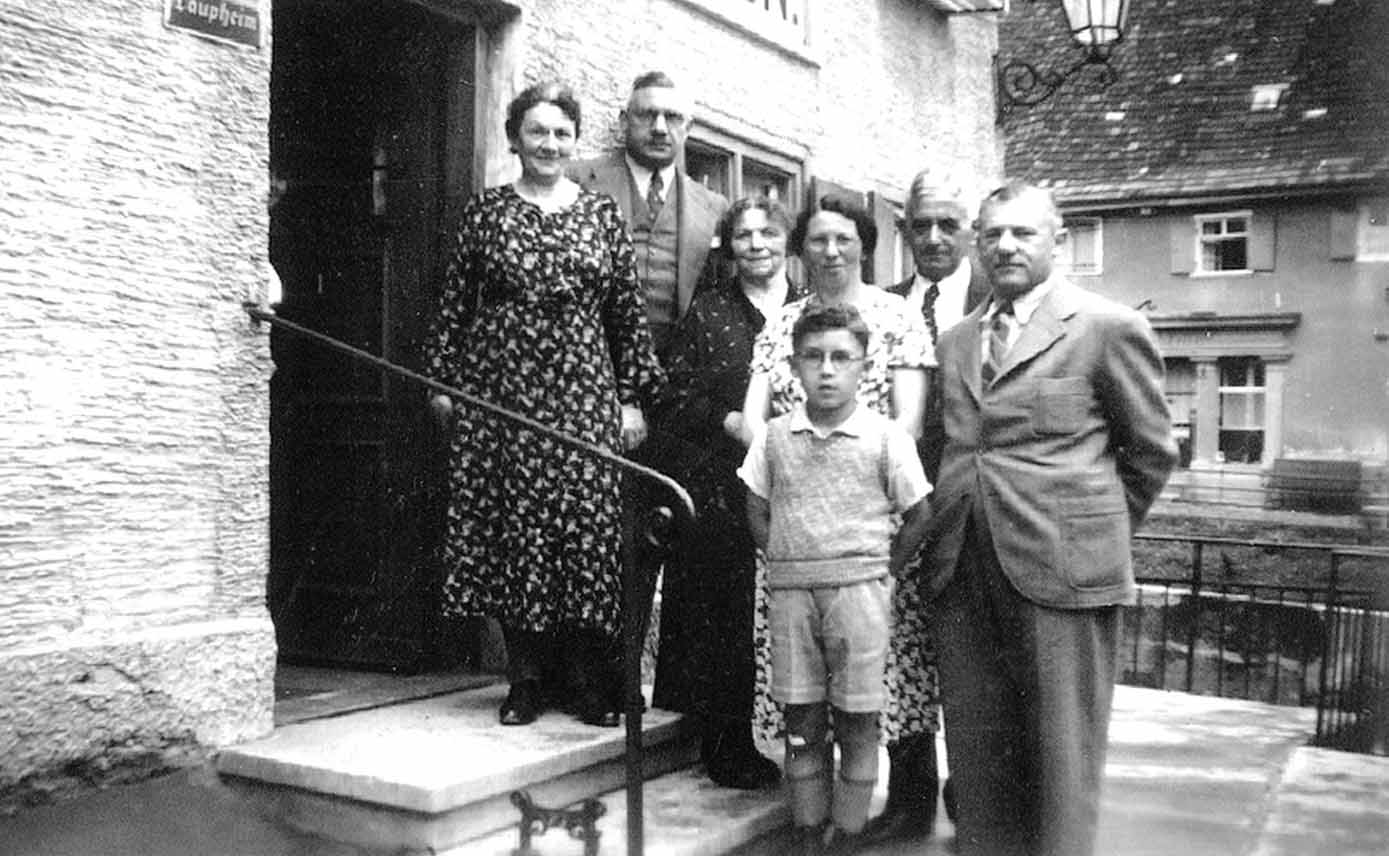
July 1938, Nördlinger-Sänger family on the stairs of the “Ochsen” with guests. From left to right: unknown couple, Klara Sänger, Sophie Nördlinger, Sam Simon, Benno Nördlinger. Boy in front: Nephew Fritz Bernheim. (Archives of Ernst Schäll)
As you would expect of a well-established, innkeeper family, there are many
pleasant photos of the Sängers and Nördlingers, mostly thanks to Ernst Schäll’s
Archives. Registered records are,
however, in shorter supply. The texts about
this family are rather short and leave many questions unanswered.
„Zum
Ochsen“
Sophie Sänger was the only child of Albert and Klara Sänger. The Sängers
took over the traditional German inn
Zum Ochsen from Albert’s father, Benjamin Sänger, who had purchased the
inn in 1860. The house had already been built around the turn of the 18th
century. The word Rot (red) was
probably added to the original name in the 1980s, after the building had
fallen into disrepair and was under threat of demolition. Following
restoration in accordance with the guidelines for the protection of
historical monuments, it was reopened under the name
Zum roten Ochsen.
In the advertisement of the Purim
magazine of 1914 it is only called
Ochsen Hotel. The advertisement makes ironic jokes about the small size
and the old-fashioned and somewhat backward style of the inn at the time, as
there were already many bigger and better inns in town. Furthermore, we
learn that tripe is a specialty and a true kosher staple.
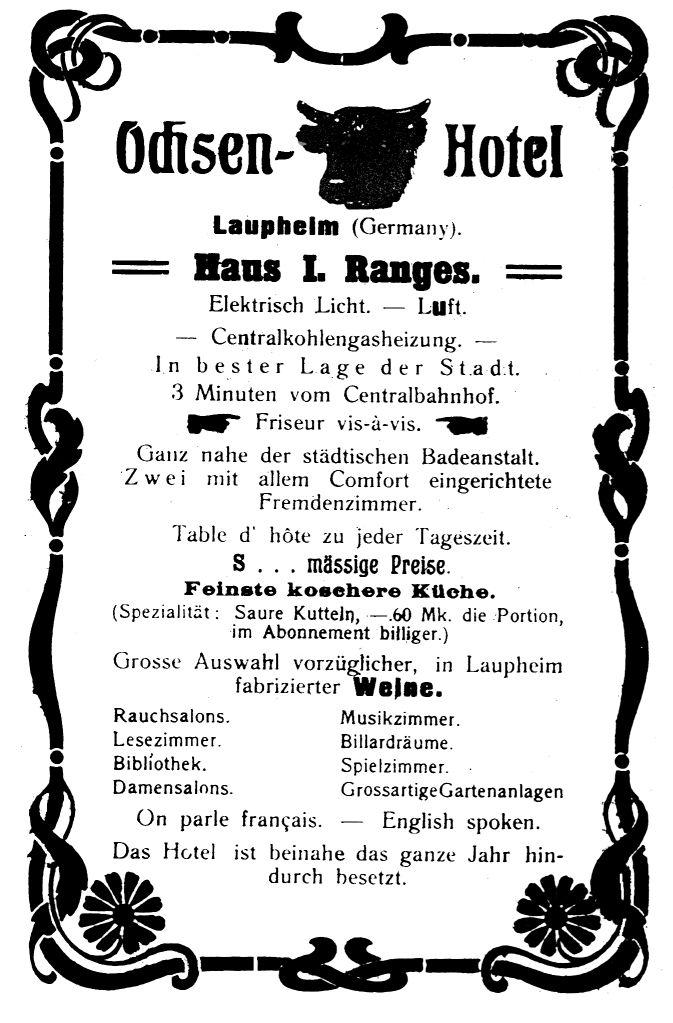
Playful advertisement from the musical society
“Frohsinn” in the “Purim” magazine of 1914.
At Purim Fair every year anonymous authors would poke fun
at what was going on in town.
(Source: property of John Bergmann, city archives Laupheim)
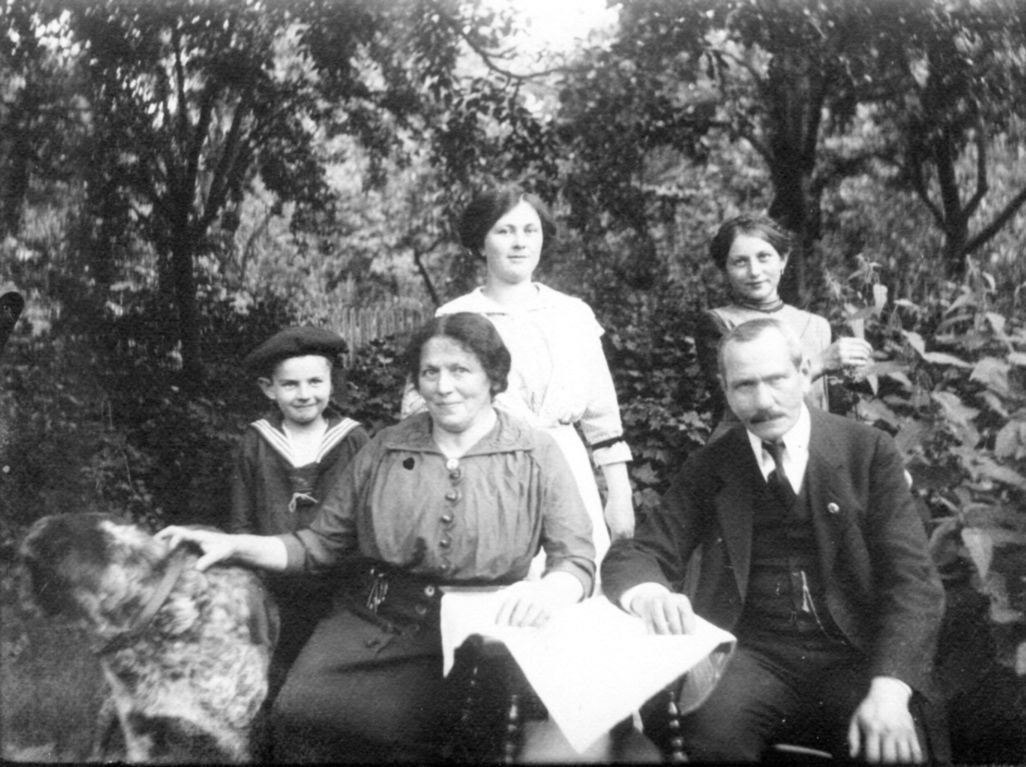
The innkeepers of Zum Ochsen:
Klara and Albert Sänger with their daughter Sophie (middle)
and two unknown children in 1914/15. Albert Sänger died in 1929.
(Archives of Ernst Schäll)
In John Bergmann’s recollections the beloved meeting place
Zum Ochsen never lost its
popularity despite increasing competition. He describes the situation during
the 1920s as follows:
People spent a lot of time in the Ochsen, one of the two Jewish-German inns. The Ochsen was a place for open discussion where Jewish people could meet, play cards and talk. Men usually met there after lunch on their way back to work for a cup of coffee (without sugar and milk, since the Ochsen strictly adhered to Kashrut, the Jewish dietary laws). During this time they also played card games such as Poker and Gaigel or read Tarot cards, but there was also room for insightful discussion on local and international issues.
(Bergmann chronicles, Page 59, 63)
Benno Nördlinger
The last Jewish innkeeper of the
Ochsen was Benno, whose parent’s home was located nine houses up
Kapellenstraße on the same side of the road as the inn. Benno was
the oldest son of the farmer Ludwig Nördlinger and his wife Pauline
(Page
394 ff.). From 1905 to 1911 he attended Laupheim
Realschule (the German equivalent of High School) and graduated with
Mittlere Reife (a high school
diploma), known as Einjähriges at
that time. On finishing his
Einjähriges, he began his commercial apprenticeship, shortly before the
outbreak of World War I. At the age of nineteen, even Benno was swept up in
the patriotic enthusiasm for war. In the autumn of 1914 he volunteered to
fight in the war, as did 13 younger members of the Jewish community of
Laupheim. During the war he fought as an artilleryman on the frontline, was
promoted to corporal and was awarded the Iron Cross 2nd class.
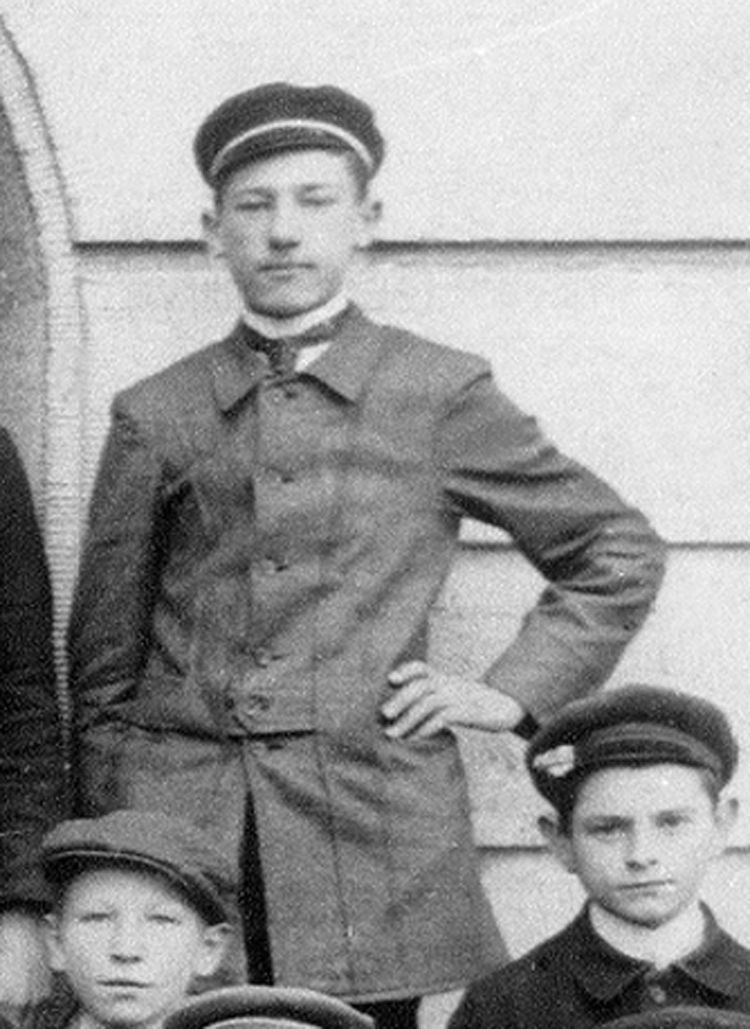
Benno Nördlinger as a schoolboy in 1911.
(Archives of Ernst Schäll)
The list of Laupheim’s 45 Jewish frontline soldiers, which is shown below,
was found on the property of John Bergmann, but unfortunately no sources are
provided. This list is surely a product of the so-called “Jewish census”
that was conducted by the Imperial Army in 1917 exclusively for statistical
purposes. This later served as part of the anti-Semitic campaign after the
war, the purpose of which was to downplay the patriotic contributions of the
German Jews. Looking closely, the number of Laupheim frontline soldiers is
striking. Most of the soldiers behind the frontline were older and are not
even listed here. This shows that Benno Nördlinger was not an isolated case.
Half of the soldiers, namely 23, were awarded an Iron Cross. Moreover, 14,
almost a third, were promoted: 10 to the rank of corporal and 4 to the rank
of officer. As promotion was usually only possible with a certain level of
education, i.e. Einjähriges, this further demonstrates that the Jewish community had
a better than average level of education.
It is estimated that Benno Nördlinger and Sophie Sänger married in early
1926. Benno became the new innkeeper of the
Ochsen. The couple, which would
remain childless, rented a house on Radstraße several houses up from the
“Ochsen”. This was due in part to the spatial constraints of the
Ochsen that are still obvious
today. Another reason for this may be the fact that Paula Seligmann, the
widowed sister of Klara Sänger, lived there temporarily. Paula Seligmann
died in 1939 in Stuttgart, but she was buried in Laupheim in the cemetery.
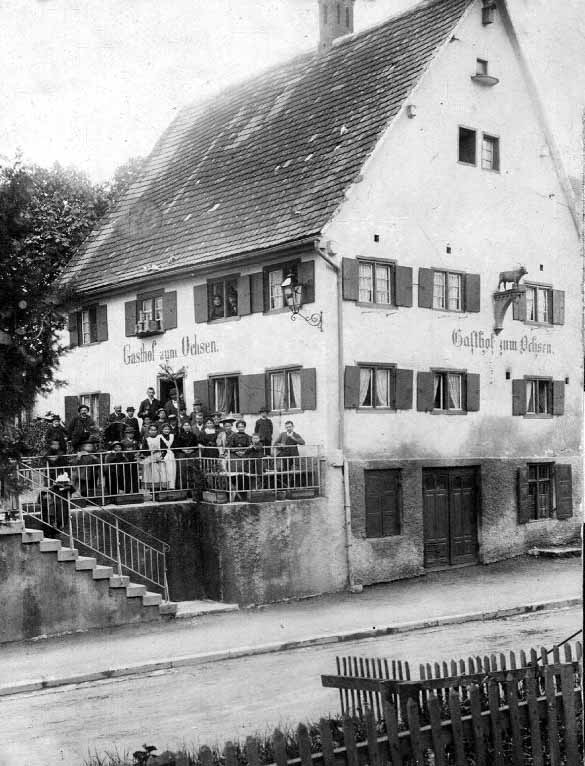
The “Ochsen” before World War I
In the 1920s Benno Nördlinger ran a paper wholesale business together with Hugo Höchstetter, however, the information available is limited. At the time Benno’s in-laws probably still ran the inn, therefore the paper wholesale business was likely to have been the main source of income for the Nördlinger family.
Jewish frontline soldiers
Name,
field unit,
last rank,
decorations,
honorable
mention
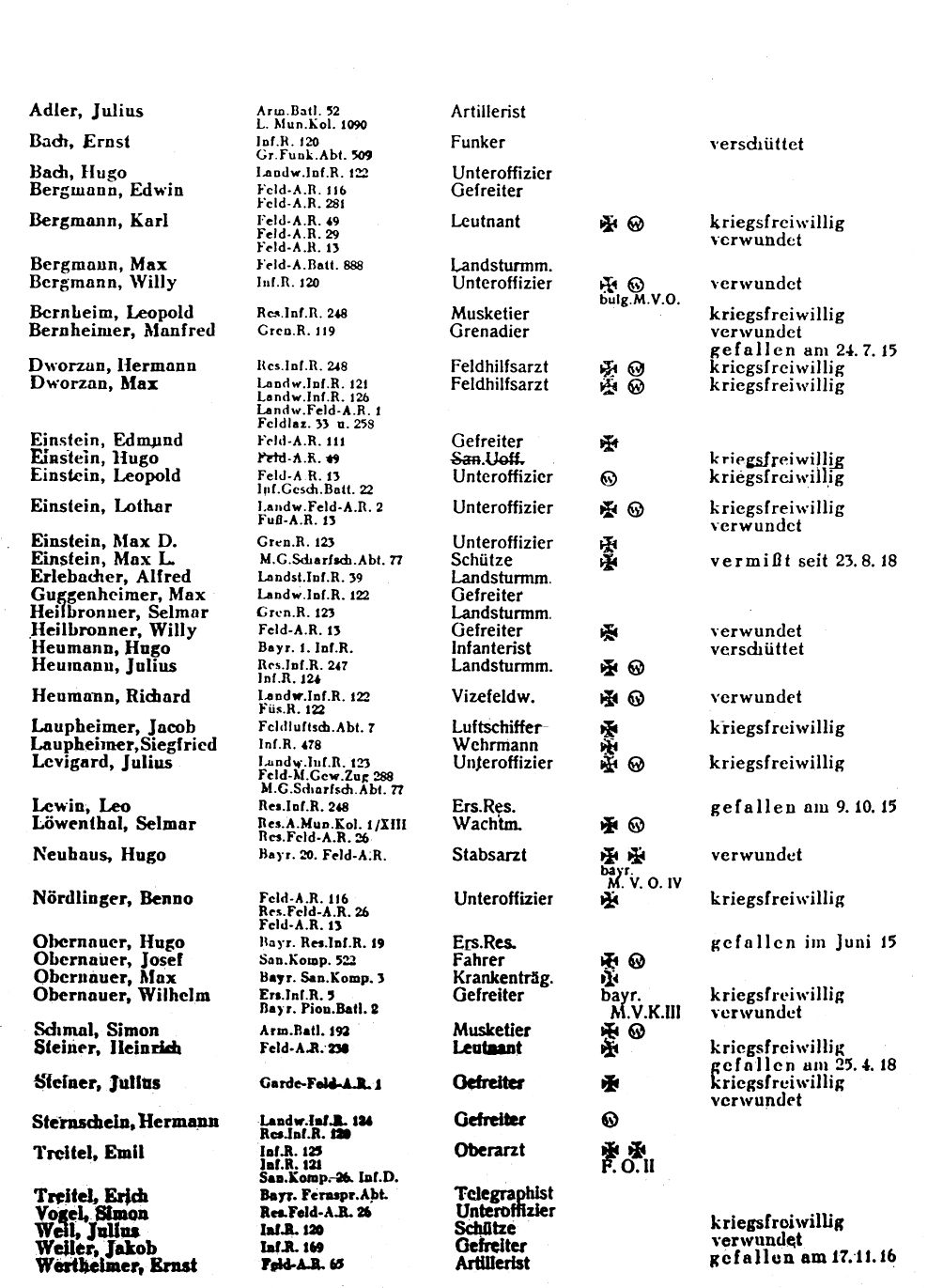
Emigration and new beginnings during the Third Reich
Due to a lack of authentic reports this chapter is rather short and limited
to key figures. John Bergmann describes how the
Ochsen became the target of SA
terror early on. After the failure of the coup d’état in Austria in July
1934 numerous members of the SA and the SS were taken in by Germany, among
others by the Steiger-Werke, a car
factory, in Burgrieden. From there they often came to Laupheim:
“What our local Nazi-units were lacking in brutality and malice, they learned quickly from their Austrian comrades. The officers were welcome guests at the homes of the ‘better families’. In 1934 these gangsters were already raging against Jews. They temporarily occupied the Ochsen inn and damaged many Jewish houses and shops.” (Bergmann-Chronicles p.85)
In 1938 during the Night of Broken Glass Benno Nördlinger was also dragged
out of his home, humiliated and subsequently deported to the concentration
camp Dachau. In a letter dated November 23, 1938 his lawyer, Ernst Moos from
Ulm, tried to negotiate with the Gestapo for a swift release.
He argued that the already initiated sale of the
Ochsen to the castle brewery could
not be finalized as long as Nördlinger was arrested. The emigration of the
family had already been prepared and the visas for the U.S.A. were about to
be issued. He also enumerated the prisoner’s decorations and honorable
mentions: almost four years of military service at the frontline, Iron Cross
2nd class, the Honor Cross of the First World War for front-line
veterans and many years of service in the medical orderly convoy.
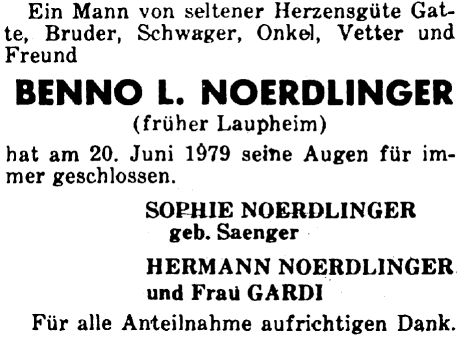
(Source: property of John Bergmann, Reel 1, Box 2)
On December 14, 1938 Nördlinger was finally released. In the end, the sale
of the inn to the castle brewery was not officially authorized; instead it
was sold privately in February 1939. Shortly before the outbreak of World
War II, on August 14, 1939, the family was finally allowed to immigrate to
New York. Even Klara Sänger who was 74 years old at the time accompanied
them. This was probably a wise decision that saved her from humiliation and
deportation. Others at her age commonly did not have the fortitude to
undertake such a long journey. She died in New York in October 1942.
Even though they had lost everything, Sophie and Benno Nördlinger were able
to build a new life for themselves in New York. In June 1979 Benno died at
the age of 84, as documented in his obituary notice that was published in
the newspaper Aufbau
(Reconstruction). His wife Sophie outlived him by many years. In November
1993 she died at the age of 96 in Chicago, in a home for the elderly. She
had lived in Chicago since 1990 to be closer to her nephew, the architect,
Fred Bernheim.
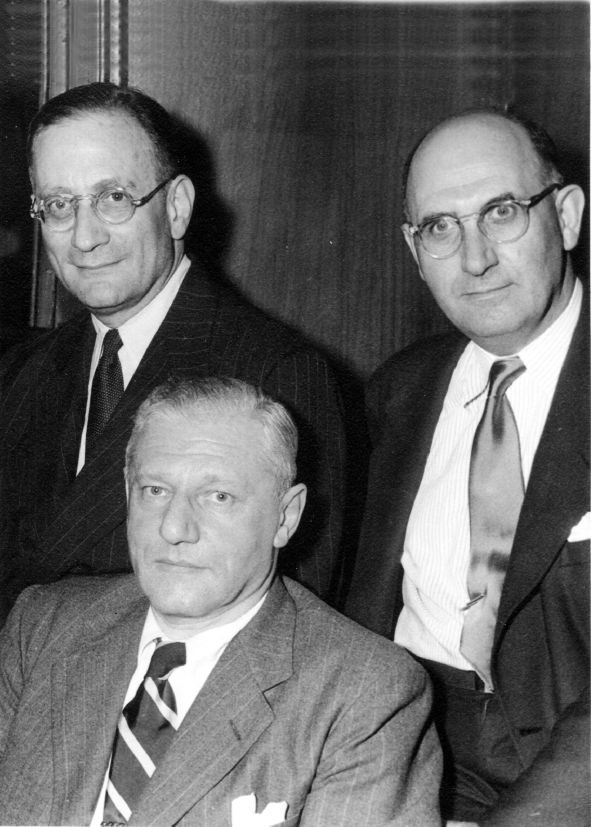
(A photo from 1950: back row: Julius and Helmut
Steiner,
In front: Benno Nördlinger - The “Grandseigneurs”
(sophisticated gentlemen)
of the destroyed Jewish community of Laupheim)
Sources:
Property of John Bergmann, City archives Laupheim,
Köhlerschmidt/Hecht: Die Deportation der Juden aus
Laupheim (“The deportation of the Laupheim Jews”)
John H. Bergmann: Die Bergmanns aus Laupheim
(“The Bergmann family from Laupheim”)